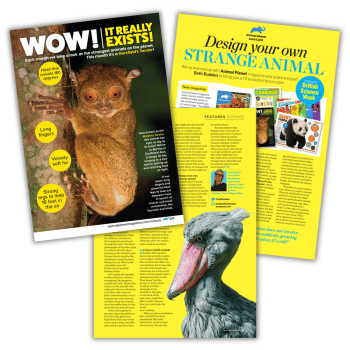One thing that is hard for children to grasp when teaching evolution and inheritance in Year 6 is how adaptation through natural selection may lead to evolution.
This lesson revolves around shoebill storks. Nicknamed ‘king of the marshes’, this is one of the world’s strangest looking birds. It can teach us much about evolution and adaptation because of its distinctive features that make it so well adapted to its environment.
Pupils will work towards designing their own unique creature that is specially adapted to a specific environment.
This download contains
- Full PDF lesson plan
- Animal Planet magazine sample page
Common misconception
A common misconception is that animals change to suit where they live in the same way that humans do. For example, we wear warmer clothes in the cold.
However, evolution does not involve animals suddenly growing hair when it’s cold, or feathers when they need to fly. Rather, it involves variations in populations that create an advantage which may mean more survive to adulthood to reproduce and pass on their adaptations.
When we teach evolution, we need to ensure that the concept of this natural selection is made clear to pupils so they understand that species evolve through a natural process over generations, and not because individuals physically change.
Evolution and inheritance Year 6 curriculum links
- Pupils will identify how animals and plants are adapted to suit their environment in different ways and that adaptation may lead to evolution
Beth Budden is assistant headteacher at a London primary school and a Primary Science Teaching Trust College Fellow. Follow her on Twitter at @bethbudden.











